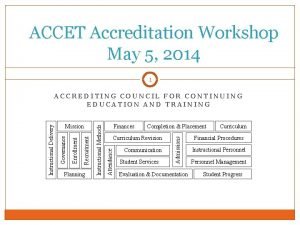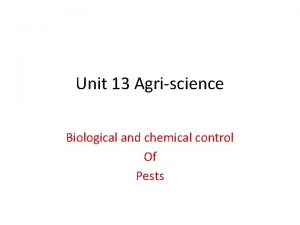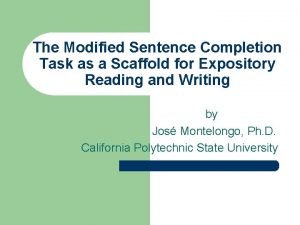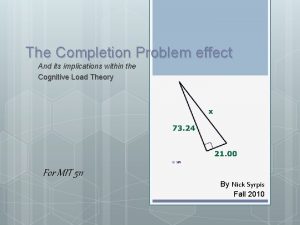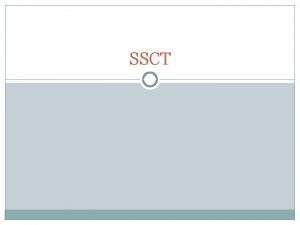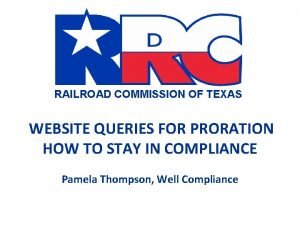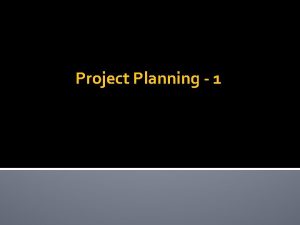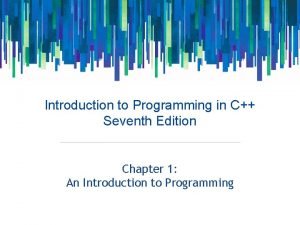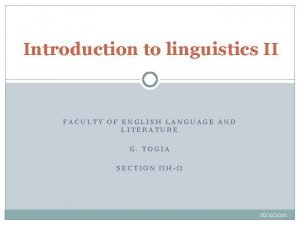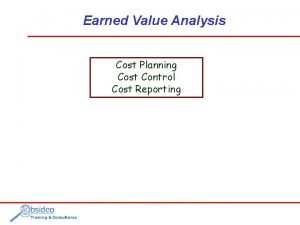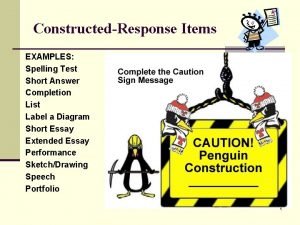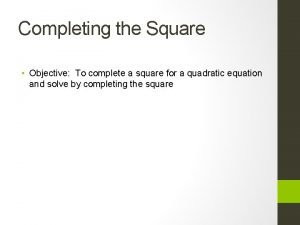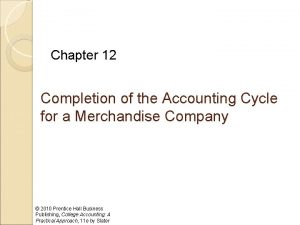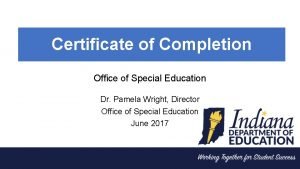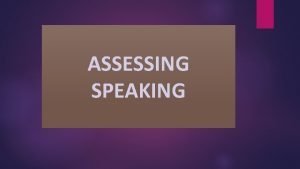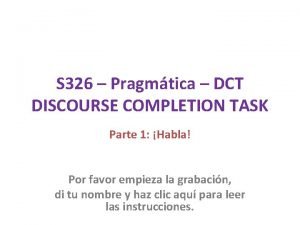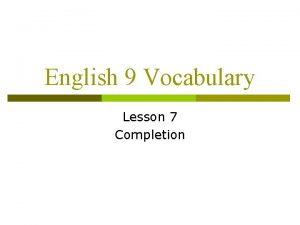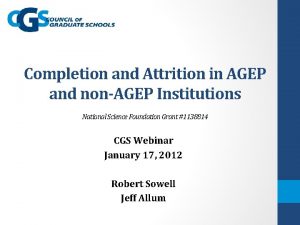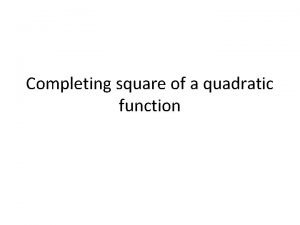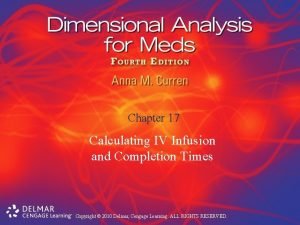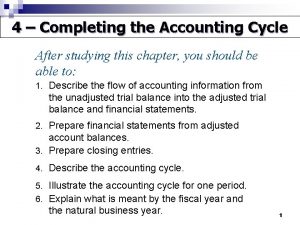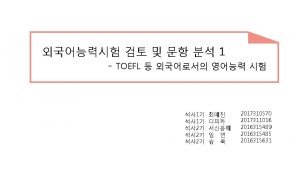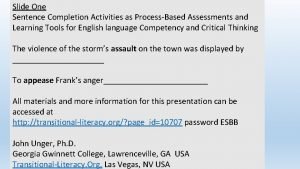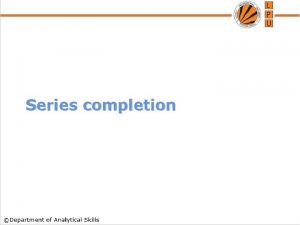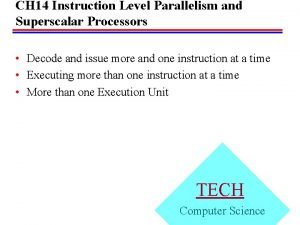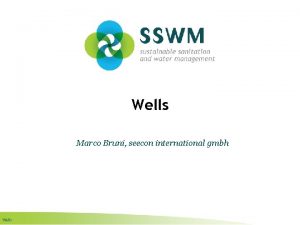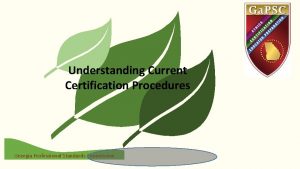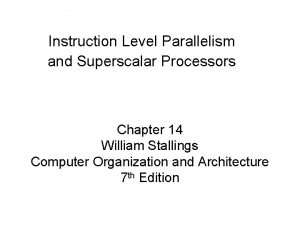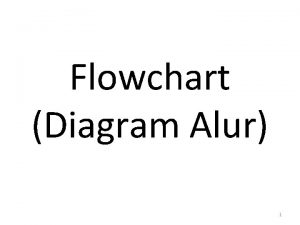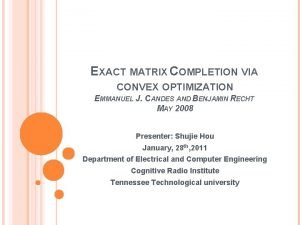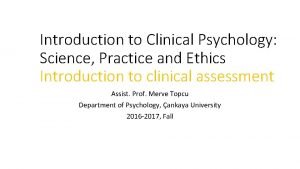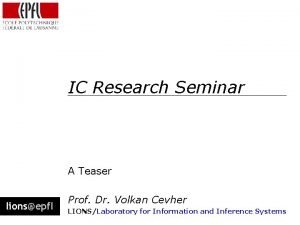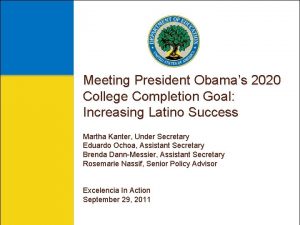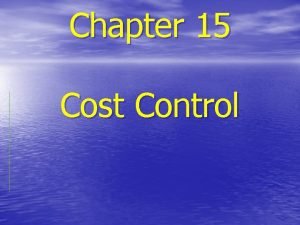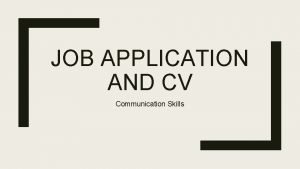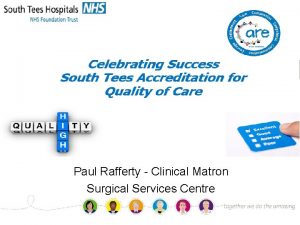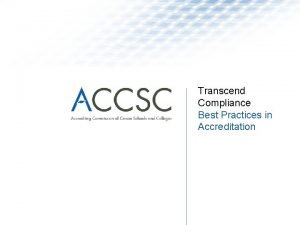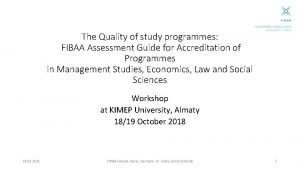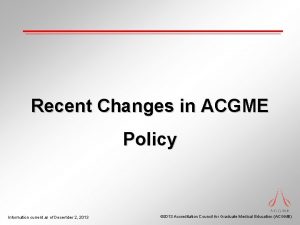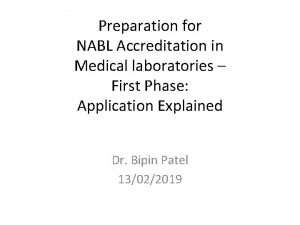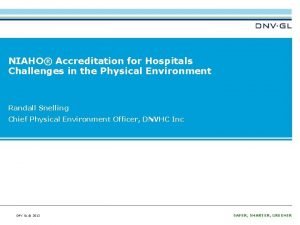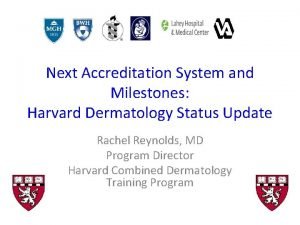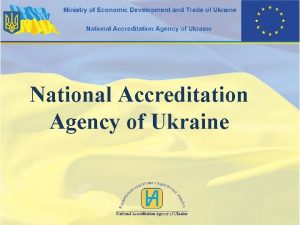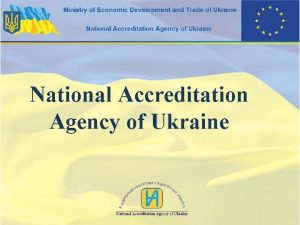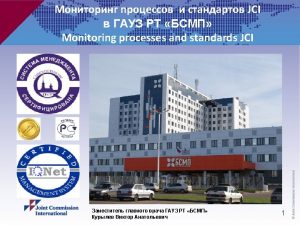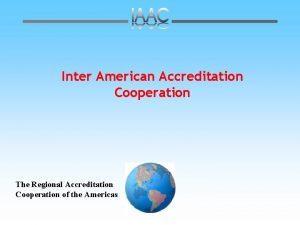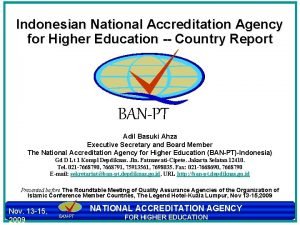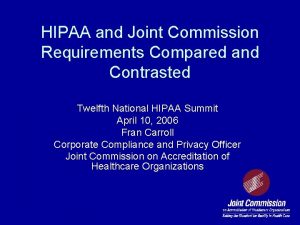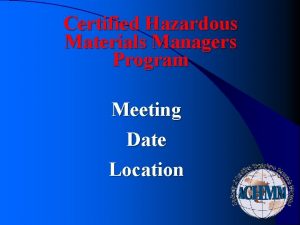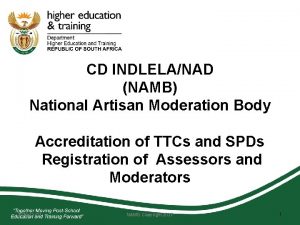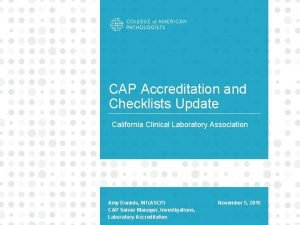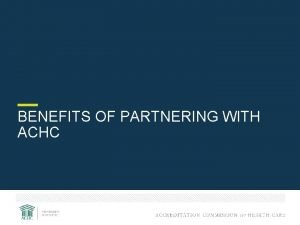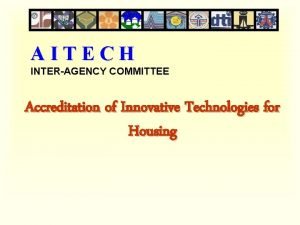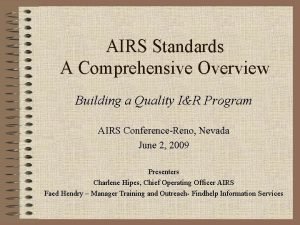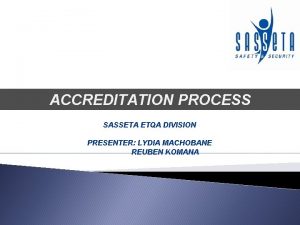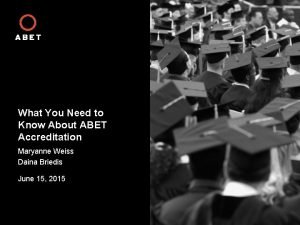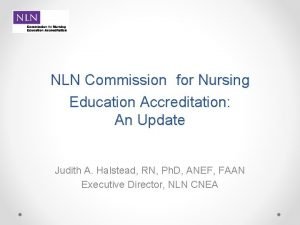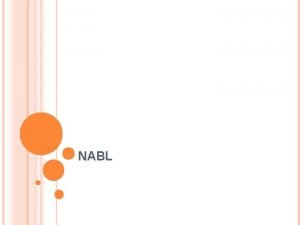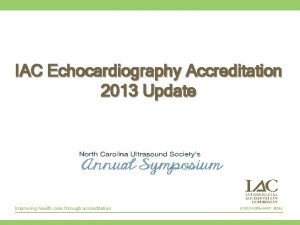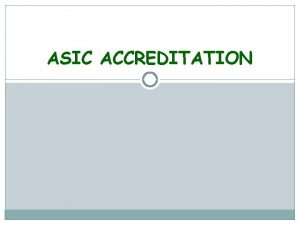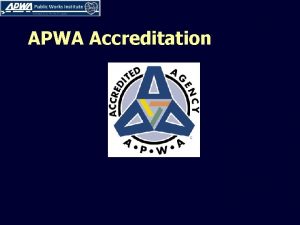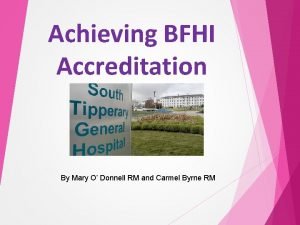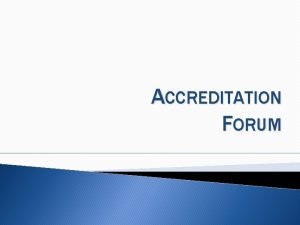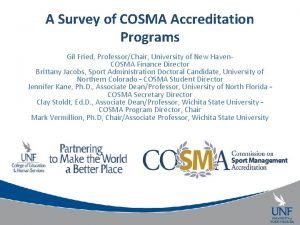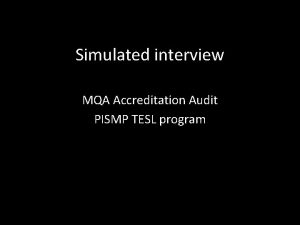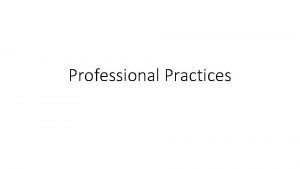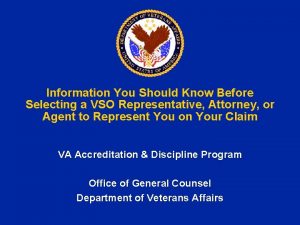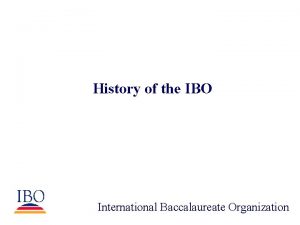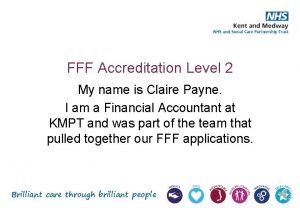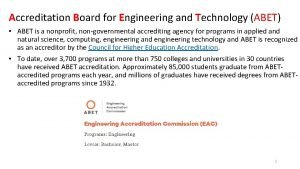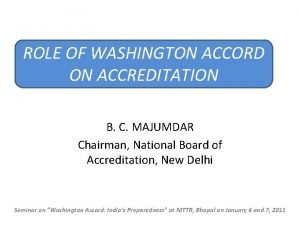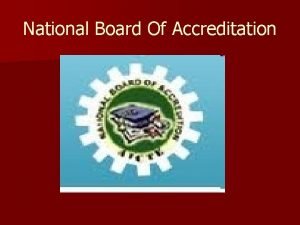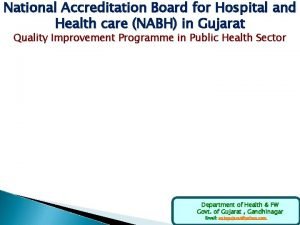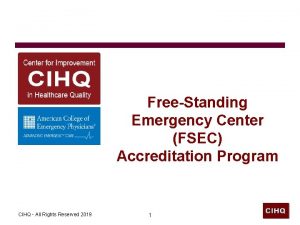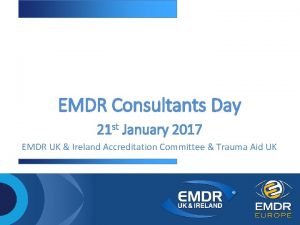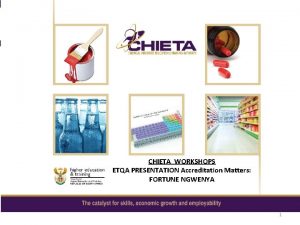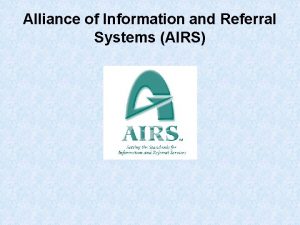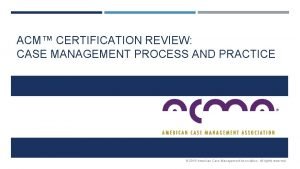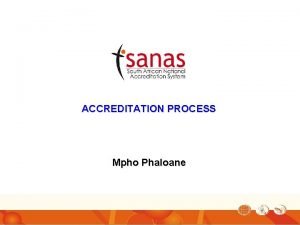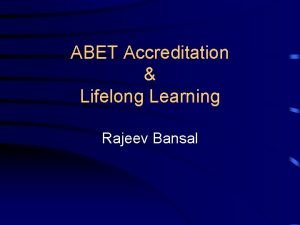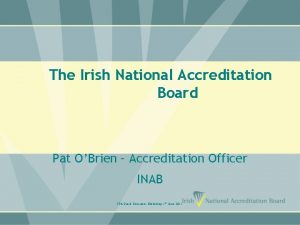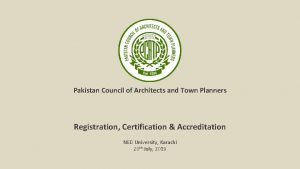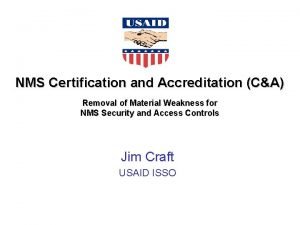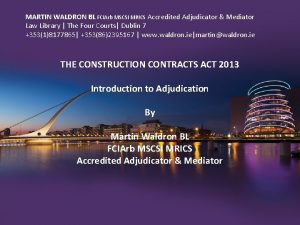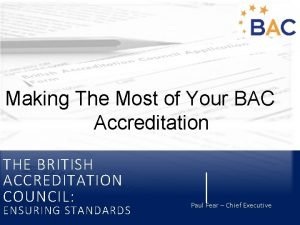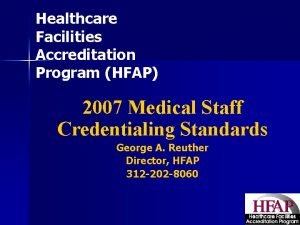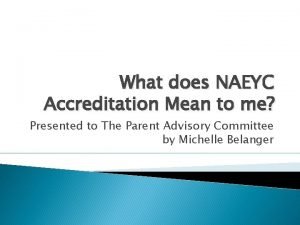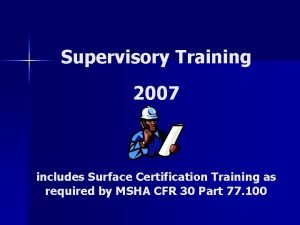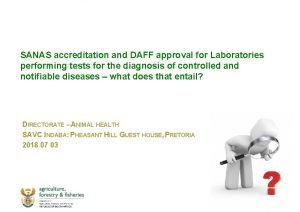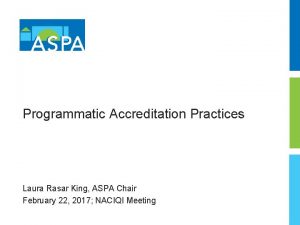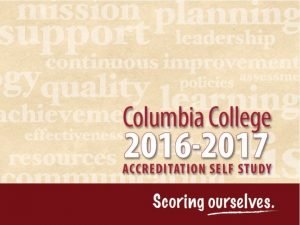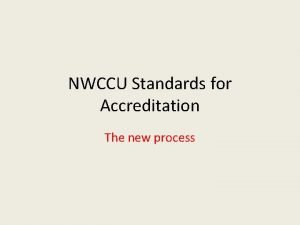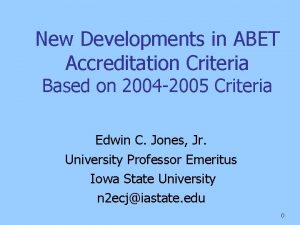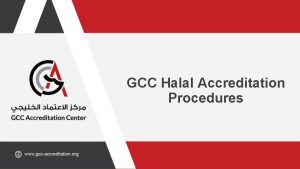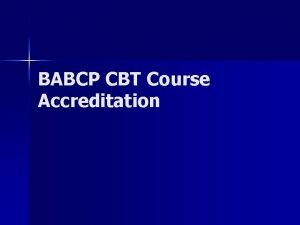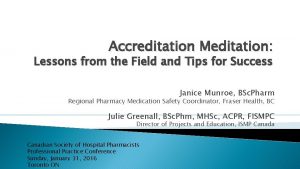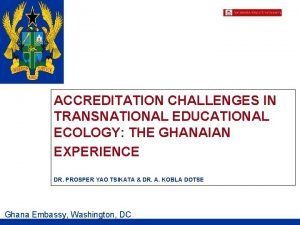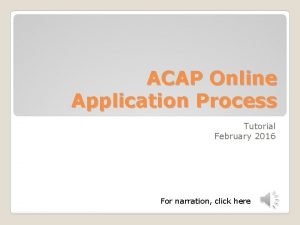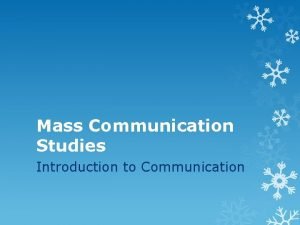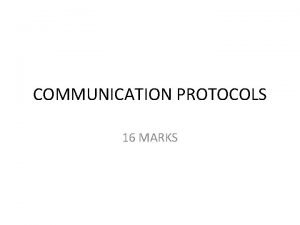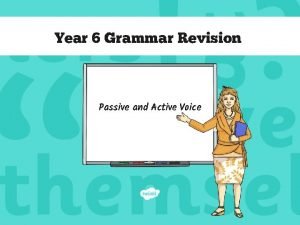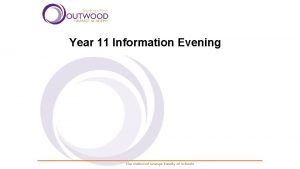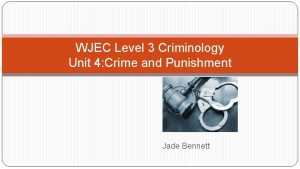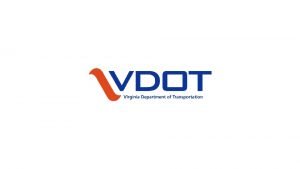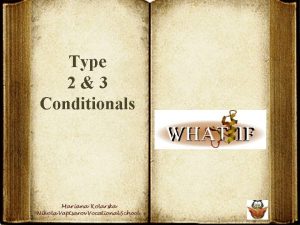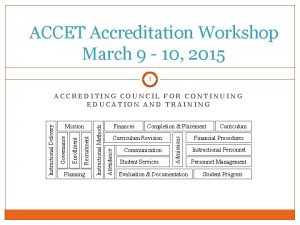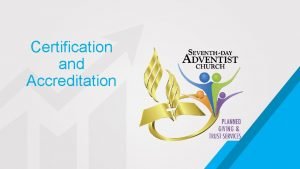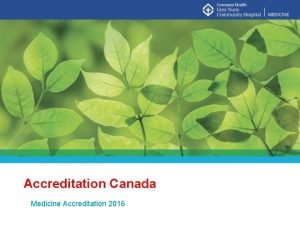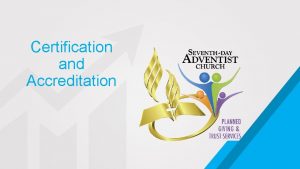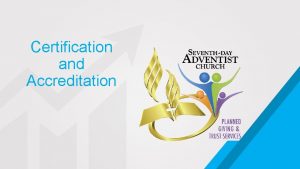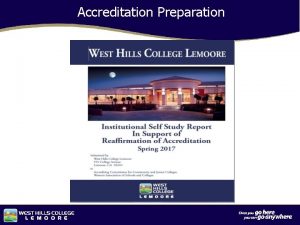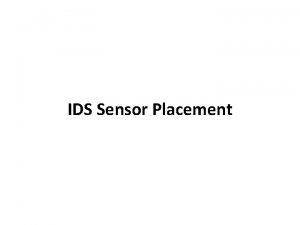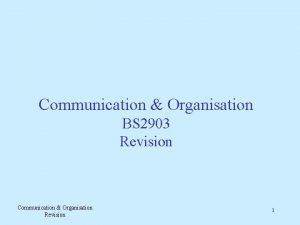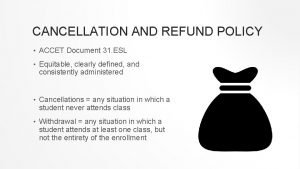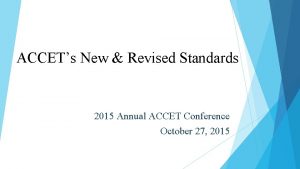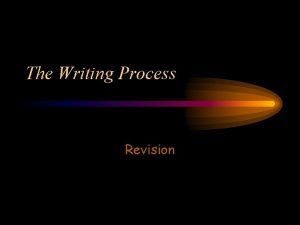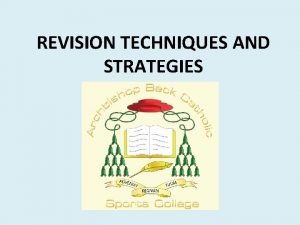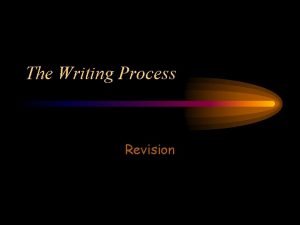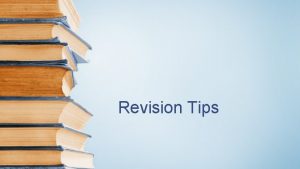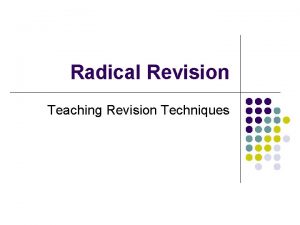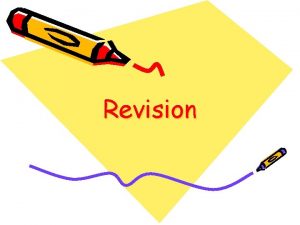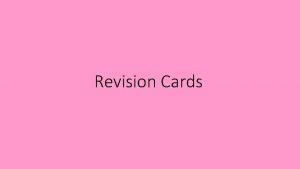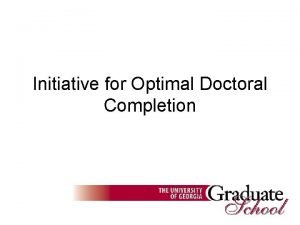ACCET Accreditation Workshop Completion Placement Curriculum Revision Communication
















































































































































- Slides: 144

ACCET Accreditation Workshop Completion & Placement Curriculum Revision Communication Student Services Admissions Finances Attendance Planning Instructional Methods Recruitment Enrollment Mission Governance Instructional Delivery September 13 -14, 2010 Irvine, California Evaluation & Documentation Curriculum Financial Procedures Instructional Personnel Management Student Progress ACCREDITING COUNCIL FOR CONTINUING EDUCATION & TRAINING

Introduction of Presenters • Scott Faulstick - Senior Accreditation Coordinator – Chair: Program Review Committee – Co-Chair: Application Review Committee (Initial) – Commission Liaison: Appeals Panel • Linsay Oakden - Accreditation Coordinator – Chair: Branching Review Committee – Commission Liaison: Completion/Placement Review Committee 2

Introduction to ACCET Staff • Roger J. Williams - Executive Director • Charles Matterson - Associate Executive Director – Chair: On-Site Evaluation Review Committee – Commission Liaison: Financial Review Committee • Judy Hendrickson - Associate Executive Director – Chair: Change of Ownership Review Committee – Commission Liaison: Standards & Policy Review Committee – ISO 9001: 2000 Manager 3

Introduction to ACCET Staff • John Gregg - Accreditation Coordinator – Co-Chair: Application Review Committee (Reaccred. ) • Kristin Georger - Accreditation Coordinator – Commission Liaison: Financial Review Committee 4

Introduction to ACCET Staff • Commission Representatives (Outside): – Vickey Hey – Thomas Tillia – Julia Laughland • Administrative Staff: – Anneka Swamy, Operations Administrator – Mischelle Boatwright, Administrative Assistant – Katelyn Schreyer, Administrative Assistant 5

Introduction by Attendees Name Title 6

Overview � Establishment of Agency ◦ Established in 1974 as a private, non-profit 501(c)(3) corporation by continuing education providers, principally associated with the Dale Carnegie organization. � Diversity/Scope of Membership ◦ Approximately 640 training sites (approx. 50% vocational & 50% avocational/professional development). Members offer continuing education, certificate and diploma programs, Occupational Associate Degrees (OAD), and interactive distance education (IDL). 7

Overview Recognition of ACCET ◦ “Recognized" by the U. S. Department of Education (DOE) as a "reliable authority“ for the evaluation of postsecondary institutions since 1978. ACCET received a 5 -year grant of recognition (the maximum length) in 2007. ACCET certified under ISO 9001: 2000 international standards as a Quality Management System since 1998. 8

Overview � Institutional Accreditation ◦ ACCET evaluates post-secondary institutions/organizations, in accordance with 33 Standards for Accreditation. � Colleagues/Peer Review ◦ Member institutions viewed as colleagues, not customers, and the public interest is both primary and complementary to ACCET’s mission. � ACCET Accrediting Commission, volunteers, evaluators and staff provide professional peer expertise, with working knowledge and experience in the field. 9

Overview • ACCET Accrediting Commission – An autonomous eleven-member Accrediting Commission, with six institutional (elected) members, and five public (appointed) members, has ultimate authority over ACCET activities. • ACCET Staff – Ten staff and four contract field representatives conduct the day-to-day operations under the authority delegated to the Executive Director. 10

Overview Self-Regulation ◦ Accreditation is a non-governmental, voluntary oversight process to assess and enhance the integrity and quality of education/training offered by postsecondary institutions. A reliable methodology is utilized to evaluate operational functions for systematic and effective implementation and to identify areas for institutional self-improvement. 11

Overview Standards, Policies and Procedures ◦ Standards for Accreditation (Document 2) are the guiding criteria under which the Accrediting Commission exercises its professional judgment. ◦ Standards were last revised, with the approval of the membership, effective October 2005. ◦ Policies and procedures are adopted by the Accrediting Commission, following appropriate callfor-comment, to augment and facilitate the interpretation of the standards in order to assure sound operational practices. 12

Purpose and Benefit of Accreditation Quality Assurance ◦ As “A Partnership for Quality®”, the ACCET accreditation process represents an organizational commitment to standards, practices, and processes focused on operational integrity and quality training. ◦ This peer review evaluation process serves to inspire continuing education and training that is current, relevant and educationally sound. 13

Purpose and Benefit of Accreditation Gatekeeper Functions � Title IV Funding ◦ Accredited vocational institutions are eligible to seek approval for federal student aid (e. g. Pell Grants, Direct Loans, FFEL, Plus) Department of Homeland Security � Department of Homeland Security ◦ Intensive English Programs and other accredited institutions may seek authorization from the Bureau of Immigration and Customs Enforcement (BICE) to enroll foreign, non-immigrant students under F, M, and J visas. Additionally, the recertification process is simplified for accredited schools. � Department of Defense Programs ◦ Tuition reimbursement for military personnel is limited to enrollment at postsecondary institutions accredited by agencies recognized by the U. S. Department of Education. � State and Local Funding Programs ◦ Accreditation assists institutions in pursuing contractual affiliations with welfare, rehabilitation, and other workforce development programs. 14

Purpose and Benefit of Accreditation � Training Contracts - � Directory/Website Listings ◦ Accreditation assists institutions seeking contracts with corporations and government agencies, which often require accreditation as a condition to bid on training proposals. ◦ ACCET accredited institutions are listed in the following directories utilized by corporate, government, and military agencies to identify credible educational organizations when establishing tuition reimbursement policies: � American Council on Education (ACE) directory of Accredited Institutions of Postsecondary Education � Council for Higher Education Accreditation (CHEA) website at www. chea. org/search � edu Domain: ◦ Accreditation permits institutions to file with Educause for the use of the. edu domain for email and website addresses. 15

Embrace the Process Take a proactive approach to the process Maintain an institutional-wide commitment to the process Emphasize outcomes – achieving specified learning goals Strive for continuous improvement through ongoing internal review 16

ACCREDITATION Schedule and General Overview.

Accreditation Process/Timeframe (Approximately 12 months) 1. 2. 3. 4. 5. 6. 7. 8. 9. Application (Doc. 4) submitted by institution Application reviewed by ACCET staff (2 -4 Months) Additional information requested by ACCET (if necessary) Attendance at Accreditation Workshop Preparation & submission of electronic Analytic Self-Evaluation Report (e. ASER) by institution On-site team visit & Team Report (2 -day visit & Team Report sent within 30 days of visit) Institution’s response to Team Report (due within 14 days) Accrediting Commission’s review and decision Commission letter (within 30 days of Commission Meeting 18

Application for Accreditation Document 4

Accreditation Review Schedule APP. PKG. e. MAILING APPLICATION e. ASER/BASER DOCUMENT 8 Aug. 14, 2009 Dec. 18, 2009 April 16, 2010 July 16, 2010 Sept. - Oct. – 2010 March 12, 2010 Apr. 16, 2010 Aug. 20, 2010 Nov. 12, 2010 Aug. 13, 2010 ON-SITE EVALUATION May - June 2010 Jan. – Feb. 2011 Dec. 17, 2011 Mar. 11, 2011 May – June 2011 COMMISSION MTG. Aug. 2 - Aug. 6, 2010 Nov. 30 - Dec. 4, 2010 March 28 – Apr. 1, 2011 Aug. 1 -5, 2011 20

Overview of Electronic Analytic Self-Evaluation Report (e. ASER) Documents: 3. 1, 3. 2, 3. 3, 3. 2/3 ESL (Combined) Overlay Templates: 3. ESL, 3. VESL, 3. IDL, 3. OAD, 3. MT, 3. NAH

Developing the e. ASER Obtain support at the highest level Commit resources Start early Assign a champion 22

Developing the e. ASER Involve the entire staff Conduct regular meetings Develop/implement new policies and procedures, as needed Tell the “story” of your institution 23

Developing the e. ASER � Use the current and appropriate ACCET Document 3 � Gather supporting documentation � Assemble � EDIT, the e. ASER EDIT, EDIT 24

Structure of Your e. ASER Narrative � Title Page � Table of Contents � Institutional Summary Profile � Written narrative addressing the eight standards (33 subsections) � Standards that do not apply 25

Supporting Documentation Documents supplementing narrative response to questions and requirements Types of exhibits Representative sample Cross-referenced in e. ASER/BASER narrative 26

Any Additional Sites Must be referenced in: ◦ The application (Document 4) ◦ e. ASER/BASER 27

Two Ways to Submission ASER 1) Submit e. ASER/BASER in CD format: Due to the ACCET office by November 12, 2010 e. ASER/BASER copied onto CD’s: – 2 copies to ACCET – 1 copy to each team member On-site fees and Document 8 Form 28

Two Ways to Submission ASER 2) Test Drive the new ACCET database You may choose to pilot the new ACCET database and submit all ASER information online, using the new ACCET Management System. Extension of ASER due date (not Doc 8 and fees) to December 5, 2010 29

Database Demonstration

Need Help…. Call ACCET for assistance: ◦ Our staff is here to help you. ◦ Never hesitate to call with any questions, concerns, or for guidance. 31

On-Site Review Team composition: ◦ Management Specialist/Chair ◦ Curriculum Specialist(s) ◦ Commission Representative 32

On-Site Review Team Selection No conflict real or perceived Approved by institution All materials confidential 33

Visit Materials To be sent electronically by ACCET before the visit: ◦ ◦ ◦ Confirmation letter Checklist of materials to be available for team Memorandum for on-site team visit Team member roster Letter of invitation sent to state licensing agency 34

Team Member Responsibilities Prior to the Visit: ◦ Review ACCET Documents ◦ Study e. ASER ◦ Identify issues for Clarification 35

Team Member Responsibilities During the Visit: ◦ ◦ ◦ Validate e. ASER representations Observe, interview, collect data/documentation Confer in team meetings Summarize pertinent facts Discuss/propose ratings, strengths, weaknesses Write assigned standards for Team Report 36

Preparation for the Visit Provide for the Team: ◦ ◦ Private room/space for the team Documents requested on the Preparation Checklist Any changes since the submittal of e. ASER Current organizational chart 37

Preparation Checklist for ACCET On-Site Examination Visit 1. A complete paper copy of the institution’s e. ASER/BASER, including all exhibits. 2. A completed copy of the program chart listing all approved programs and enrollment/staffing information (see www. accet. org/Documents and Forms/Fillable Documents). 3. A complete roster of all active students, including start dates, and a listing of students on leave of absence (LOA). 4. A listing of all students who graduated, withdrew, or were terminated within the past 12 months. 5. List of all students by name, program title, certificate/license sought, and date of graduation who were eligible for, attempted, or attained certification/licensure within the past 12 months (Vocational). 6. A current organizational chart with names and job titles. 7. An updated staff turnover listing and calculated rates (separately for full/part time) since the submission of the e. ASER/BASER. 8. Schedules for all faculty and administrative staff during the visit, including room locations, break times, office/teaching hours, and courses/classes being taught. 38

Preparation Checklist for ACCET On-Site Examination Visit 9. 10. 11. 12. 13. 14. 15. 16. 17. Correspondence files of all communications with ACCET, state and federal agencies. Administrative operations/procedures manual. if not included in its entirety in the e. ASER/BASER. Personnel policies/employee handbook, if not included in its entirety in the e. ASER/BASER. A listing of who is responsible for and the location of personnel records for all employees, including any new or updated resumes or ACCET Document 6 s - Personnel Form, job descriptions, and performance evaluations. Minutes of all staff and faculty meetings for the past 12 months ACCET Document 50 FR – On-site Examination Team Financial Review Checklist. ACCET Document 50 FA – On-site Financial Aid Review Checklist/ Guidelines (Title IV eligible). ACCET Document 50 I – On-site Immigration Compliance Checklist/ Guidelines (Institutions authorized to enroll F 1/M 1 visa students). State-licensing agency's cancellation and refund policy (if applicable). 18. Complete sets of curricular materials, including syllabi, lesson plans/ instructor guides, testing and evaluation tools, text materials, and student performance standards 39

Preparation Checklist for ACCET On-Site Examination Visit 19. Current school catalog and completed ACCET Document 29 Catalog Guidelines and Checklist (Vocational) 20. Current enrollment agreement and completed ACCET Document 29. 2 - Enrollment Agreement Checklist (Vocational). NOTE: Avocational institutions must provide only a copy of their enrollment agreement/student application 21. Sample entrance examinations/criteria/test scores used to accept students (i) with a high school diploma/GED and/or (ii) who are admitted on a designated ability-to-benefit admissions basis 22. Samples of all advertising/promotional materials used by the school at any time during the past 12 months 23. Most recent fire and safety inspection certificates 24. Year-to-date ACCET Document 28. 1 - Completion and Placement Statistics for each program (Vocational) 25. Names and email addresses of current students, graduates in the last 12 months, and 10 employers. 26. ACCET Document 12 – Annual Report and Enrollment Statistics completed for your institution’s most recent fiscal year ending (Initial Applicants). 40

The Visit Introductory meeting Tour of facility Information gathering process Exit briefing 41

Team Report Consensus document Draft report reviewed and verified by Team Chair Team Report sent electronically to institution within 30 days of visit 42

Team Report ACCET Rating Scale 4 – Exceeds standard 3 - Acceptable and meets standard 2 - Weak, some changes needed to meet standard 1 - Unacceptable, major changes needed to meet standard 43

Responding to Weaknesses Submit response within 14 calendar days of receipt of Team Report. Respond in response boxes embedded in Team Report. Prepare response with the same thought and thoroughness as e. ASER/BASER. Address any weakness cited in Team Report and referenced to a specific standard. 44

Responding to Weaknesses Link and clearly reference the exhibits that support response. Ensure that response clearly reflects understanding of : 1. Cited weakness(es), 2. Corrective action taken, and 3. Evidence that corrective actions were systematically and effectively implemented. Submit ASER online – respond to team report online. 45

Commission Meeting • Possible Commission Actions: – Accredit/Approve – Defer – Deny • • • Consensus Process Written notification sent electronically (within 30 days of Commission Meeting) Official Commission’s actions not revealed, prior to Commission letters being sent 46

ACCET Accreditation Standards I. III. IV. V. VIII. Mission Management Finances Curricula Instructional Delivery Instructional Personnel Admissions and Student Services Evaluation 47

Mission A school's mission statement is a constant reminder to its employees of why the school exists and what the founders envisioned when they put their fame and fortune at risk to breathe life into their dreams. Woe to the school that loses sight of its Mission Statement for it has taken the first step on the slippery slope to failure. 48

Standard I - Mission A. Mission Statement: • The institution clearly states its mission, thereby providing a definitive basis upon which to deliver and assess the education and training programs in an ethical, quality management environment. • The reasons for offering the education and training are consistent with the institution’s mission and are documented by either a needs assessment or market experience. 49

Consider this… A Mission Statement communicates the institution’s purpose and objectives. The mission contains your school's "winning idea" - separates you from your competitors. Is the institution meeting its mission? What criteria is used to measure success? 50

More… How do you measure and verify that training is consistent with: ◦ your stated mission; and ◦ needs assessment or market experience. The mission is refined to create a concise and precise statement which expresses your ◦ purpose, ◦ measurements of success, ◦ results 51

Standard I - Mission B. Goals: Broad institutional goals are clearly stated, inform and support the mission statement, and are understood at all levels of the organization. 52

Consider this… Goals must be: ◦ Tied to the mission. ◦ Understood at all levels of the institution. ◦ Re-evaluated periodically to ensure relevance to the institution’s mission. 53

Examples of Institutional Goals • • • To provide programs of study that are educationally sound, up-to-date, of high quality and demonstrably effective. To maintain a clear and consistent admissions process that accurately represents the program and the institution while producing enough enrollments to sustain the institutions. To provide effective student services that recognize individual differences and to ensure successful student retention, graduation, and employability where applicable. 54

Examples of Institutional Goals • • • To establish and maintain employer relationships to ensure industry contacts necessary for student success. To demonstrate the effectiveness of private educational training, thereby providing essential skills to support a productive workforce. To ensure proper and ethical administration of all financial aspects of the institution. 55

Standard I - Mission C. Planning: • The institution has sound, written one-year and longer-range plans that encompass both the educational and business objectives of the institution. • • The plans support the mission, facilitate the accomplishment of the institutional goals, and are updated at least annually. The plans include clearly defined specific objectives and operational strategies with time frames, resources, and measurable results identified for subsequent evaluation. 56

A Business Plan Is NOT… Only a budget A market research report/analysis A to-do list or wish list 57

A Business Plan … • Supports the Mission • Relates to Institutional Objectives • • Facilitates your ability to provide quality training Addresses various aspects of school operations 58

A Business Plan Is… S - Specific M - Measurable A - Attainable R - Resources Allocated T - Time Based E - Evaluated R - Revised 59

S - SPECIFIC Which of these is specific? ◦ ◦ ◦ Raise the profile of the school Improve marketing literature Enhance curriculum Provide catalog in Spanish Increase gross revenue by 10% 60

M – MEASURABLE Which of these are measurable? ◦ ◦ Diversify the student body Enhance student services Increase enrollment in each program by 10% Obtain student feedback 61

A - ATTAINABLE Which of these is attainable? ◦ ◦ Double enrollment next term Increase applications by 4 per week Build new building to house all school functions 100% student satisfaction 62

R – RESOURCES ALLOCATED Financial Personnel Equipment Materials Who is responsible? 63

T – TIME BASED Which of these is time based? ◦ Open a new branch ◦ Offer internet based student evaluations by December 2011 ◦ Increase revenue by 10% in 2011 ◦ Expand web activity 64

E - EVALUATE Written policy for regular review Status reports – oral or written Administrative staff meetings Regular budget reviews Year-end reports Documentation of all of the above 65

R - REVISE Determine obstacles or problems Plan alternatives Determine if change is required Adjust plan in response to current conditions Re-write/communicate new plans 66

Standard II-Management A. Governance: • The institution has a governing board and/or senior management team that is responsible for developing and maintaining an effective framework of written strategies and policies. • This management structure ensures the integrity and effectiveness of the institution and its compliance with statutory, regulatory, and accreditation requirements. 67

Key Points • Clearly and accurately describe: – Ownership • Breakdown of the owners and their percentage ownership • Type of legal entity (e. g. non-profit/for-profit & Inc. /LLC. ) – Senior Management • Structure, relations to owners, reporting requirements • Titles, responsibilities, authority – Process for developing, disseminating, and revising policies & procedures • Examples 68

Key points Compliance with State, federal, accreditation requirements: ◦ State license and expiration date ◦ Approved programs (consist with state & ACCET approvals) ◦ SEVIS approval (ACCET Document 50 -I) ◦ Department of Veterans Affairs, WIA, etc. 69

Consider this… Before submitting the e. ASER: ◦ Written policies and procedures should be fully developed (revised, as necessary), implemented, and reviewed for effectiveness. ◦ Operational and educational systems should be developed and tested to ensure systematic and effective implementation. 70

Standard II - Management B. Operational Management: • Operational management is responsible for systematically and effectively implementing the strategies and policies of senior management within an organizational framework that is clearly defined, understood, and effective. • Written policies and procedures guide the day -to-day operations of the institution. 71

Key points • Who are in charge of day-to-day operations? Identify Operational Management. – Identify individual titles, roles, authority, reporting – Provide an organizational chart • How does management ensure systematic and effective implementation of policies and procedures? – Describe how faculty/staff feedback is solicited – Provide examples of faculty/staff feedback being used to change policies/procedures • What is the impact of accreditation on the quality and effectiveness of the institution? 72

Consider this… • • Is management knowledgeable and supportive of the accreditation process? Do they embrace the process? Are staff/faculty knowledgeable and supportive of the accreditation process? • Who is going to be involved and at what level? • Do you regularly discuss at staff/faculty meetings: 1. 2. 3. The accreditation process e. ASER preparation Visit preparation 73

Standard II - Management C. Personnel Management: • Management develops, implements, and maintains overall policies and procedures for the systematic and effective recruitment, selection, hiring, and retention of all personnel. • Management provides orientation, supervision, evaluation, and training and development of its employees to ensure that qualified and capable personnel, at appropriate staffing levels, are placed and effectively utilized. 74

Key Points • • • Develop and distribute an employee handbook/manual with written personnel policies. Establish a process and schedule formal personnel evaluations to occur at least annually. Create a checklist and audit personnel files for completeness to include: – – • Current personnel evaluations ACCET Document 6/resumes Evidence of in-service and other professional development W-4 and I-9 Monitor staff turnover and take steps to reduce, if necessary. 75

Employee Manual should be detailed, useful, clear and include: • Table of contents • • • Job descriptions for each position Detailed descriptions of duties/functions of each position Personnel policies & procedures related to: (1) recruiting, hiring, orienting; (2) supervising personnel and (3) providing professional development. 76

Standard II - Management D. Records: • The institution has an organized recordkeeping system that ensures all records are maintained in an accurate, orderly, and up-to -date manner. • The record-keeping system facilitates convenient review of those records by appropriate parties. 77

Standard II - Management D. Records: (continued) • All records are protected from unauthorized access and undue risk of loss. Employees and students have appropriate access to information contained in their files. • Records are maintained for a period of time consistent with applicable statutes, regulations, and sound business and educational practices. 78

Key Points • Establish an effective recordkeeping system (with file checklist) to ensure that records are: 1. 2. 3. • • • Accurate and up-to-date Organized for the convenient review by appropriate parties Accessible to students and appropriate parties Establish procedures for backing-up and storing computer files on a regular basis. Protect records from unauthorized access. Maintain a written record retention policy, consistent with state/federal regulations and sound business practices. 79

Standard II - Management E. Communication: • Management ensures regular and effective communication among all members of the institution on matters affecting the delivery of quality education and training services in order to enhance operational effectiveness. • Periodic meetings with employees are conducted with appropriate documentation maintained on significant issues consistent with the size and purpose of the institution. 80

Key Points • • Provide samples of internal communication demonstrating effective & regular communication. If the institution is a branch or part of a larger organization – describe how, when, in what form, and under what circumstances communication occurs. Describe schedule and focus of faculty, staff, & board meetings and provide documentation of meetings (i. e. agendas, minutes) Describe how new and revised policies/procedures are communicated. 81

Standard II - Management F. Professional Relationships: • The institution establishes relationships with other organizations within the education/training and employer/industry network. • These relationships are maintained, utilized, and documented to enhance the quality of the education and training services. 82

Key Points • List professional relationships between the institution and others including: 1. 2. 3. 4. 5. • Higher education institutions Professional and trade organizations/associations Industry contacts Advisory boards Other organizations/agencies Give example of how these relationships have enhanced the institution’s capabilities. 83

Standard III - Finances A. Stability: • The institution demonstrates a record of responsible financial management with resources sufficient both to maintain quality training and educational services and to complete the instruction of all enrolled participants. • Financial reports provide clear evidence of financial stability and sound fiscal practices. 84

Key Points • The overall financial stability of the institution will be determined by the Accrediting Commission: – Based upon a review of the institution’s financial statements by Financial Review Committee (FRC); and – In accordance with ACCET Document 27 – Guidelines for Filing Financial Reports. • The on-site team will review the institution: – In the context of ACCET Document 50 FR – On-Site Examination Team Financial Review Checklist; and – Based on an on-site verification of financial practices including the accuracy and availability of information. 85

Standard III - Finances B. Financial Procedures: • • The institution assesses its finances at adequate intervals, not less than quarterly. Written policies/procedures exist for proper financial controls and supervision of financial management staff. Tuition charges are applied fairly and consistently. Receipt of tuition payments and other monies is properly recorded and tracked. 86

Standard III - Finances B. Financial Procedures (continued): • Written cancellation and refund policies: – Are fair and equitable; – Are consistently administered; and – Comply with statutory, regulatory, and accreditation requirements. • Qualified and capable individuals manage and evaluate the effectiveness of the financial operations and practices. 87

Standard III - Finances C. Financial Assistance/Scholarship: • Institutions administering public and private student assistance programs, including scholarships, ensure that these programs are responsibly managed. • State and federal financial aid programs are properly administered to ensure full compliance under relevant statutes and regulations. 88

e. ASER Questions/Statements Describe any public or private resources students utilize to cover the cost of their tuition and how they are administered. Describe all scholarships, tuition discounts, and tuition waivers offered by or at the institution. 89

e. ASER Questions/Statements Applicable to Title IV Institutions: Describe the qualifications of the financial aid administrator. Does the institution utilize a financial aid processor, servicer, or consultant? Describe the processes by which the financial aid department monitors satisfactory academic progress (SAP). 90

e. ASER Questions/Statements Applicable to Title IV Institutions: • • • What is the institution’s cohort default rate for each of the past three years? Does the institution maintain a default management plan? Provide a copy of the Summary of Findings and Corrective Action Plan from the most recently filed Student Financial Aid (SFA) Compliance Audit. The on-site evaluation team will complete ACCET Document 50 FA – On-Site Financial Aid Review Checklist/Guidelines, and will review specified SFA audits and program reviews. 91

Standard IV - Curricula A. Educational Goals and Objectives: • The institution’s programs and courses have appropriate educational goals and objectives. • • The curricular content and learning experiences are preplanned and present a sound, systematic, and sequential educational methodology. Sufficient and appropriate knowledge and skill elements are included to ensure adequate preparation for the expected performance outcomes in the specific program or course for which the students enroll. 92

Standard IV - Curricula A. Educational Goals and Objectives (continued): When required as part of a program, an externship/ internship or other trainingrelated work experience is based on a preplanned outline of the specific knowledge, skills, and experience to be acquired. 93

Standard IV - Curricula B. Program/Instructional Materials: • Program materials, including syllabi, lesson plans, instructional guides, and texts demonstrate the appropriate scope, sequence, and depth of each program or course in relation to the stated goals and objectives. • • • Instructional materials, including supplementary textbooks, software, learning activities, visual aids, electronic links, and other teaching tools support the goals and objectives. All materials are up to date, readily available, and facilitate positive learning outcomes. 94

Standard IV - Curricula C. Performance Measurements: • Performance measurements are written and are periodically evaluated and updated to ensure instructional effectiveness. • • Measurements are consistently utilized and validated. The institution has a sound, written assessment system that contains a set of defined elements, such as grading scale, weighting factors, tests, quizzes, reports, projects, attendance, and participation, that are appropriately related to the performance objectives of the course or program and consistently implemented. 95

Standard IV - Curricula D. Curriculum Review/Revision: • The institution uses effective and systematic procedures, including completion and, if applicable, placement results to continuously monitor and improve the curriculum. • • The written procedures include soliciting feedback from relevant constituencies, such as faculty, students, graduates, employers, and advisory/certification boards. The procedures focus on a comprehensive review of the curriculum as it relates to the expected learning outcomes. 96

Standard IV - Curricula E. Certification and Licensing: • When the purpose of instruction is to prepare students to meet the standards for licensing, certification, registration, or examination requirements, the curriculum includes appropriate preparation and materials to meet the requirements for such credentials. • The institution records and tracks the pass rates of graduates and uses the results to measure and improve the quality of the educational programs offered. 97

Consider this… • • Describe the certification process for each program. How do the curriculum/materials prepare students for the exam? Prepare a chart of examinees and analysis of data with pass rates on these exams for the last 2 years. Describe the process of tracking the success rate – who and how? 98

Standard V – Instructional Delivery A. Instructional Methods: • • Instructional methods encourage active and motivated responses from participants. Policies and procedures are in place to ensure that the curricula are followed and that there is consistency of application by all instructional staff. The instructional methodology is consistent with contemporary training industry standards and appropriate to the educational goals and curricular objectives, facilitates learning, and serves the individual learning needs and objectives of participants. 99

A. Instructional Methods (continued): • Instructional methods provide encouragement, challenges, and learning opportunities for all enrolled participants, taking into account different backgrounds, learning abilities and styles, and prior levels of achievement. 10 0

Standard V – Instructional Delivery B. Externships/Internships: • Written policies and procedures for the supervision and evaluation of externships/internships are established and followed by the institution to ensure consistency and effectiveness. • The institution provides an adequate number of sites to ensure appropriate and timely learning experiences in its externship/internship program. 10 1

Consider this… • • • Provide the policy for the administration of the externship/internship program. Describe how sites are selected, evaluated, and/or inspected. Describe how student performance is monitored and documented (performance evaluations & attendance). 10 2

Standard V – Instructional Delivery C. Equipment/Supplies: Adequate, appropriate, and functional equipment, supplies, and furnishings required to effectively provide the education and training services are readily available for instructor and participant use. 10 3

Standard V – Instructional Delivery D. Facilities: • The characteristics of the facility are suitable and serve to enhance the education and training services offered. • • Instruction is conducted in a safe, accessible, sanitary, and comfortable environment, which is free from distraction. The facility meets all applicable local, state, and federal requirements. 10 4

Standard VI – Instructional Personnel A. Qualifications of Instructional Personnel: • Instructional personnel possess the appropriate combination of general education, specialized training, experience, and demonstrated teaching and classroom management skills, which qualifies them for their training assignments. 10 5

Consider this… • • • What are your requirements for hiring instructional personnel (minimum years of experience, education, certifications, expected teaching style & presentation skills)? Are there state licensing requirements relative to instructor qualifications? What are the requirements identified in 3. ESL and 3. OAD? 10 6

Standard VI – Instructional Personnel B. Supervision of Instruction: • Individuals with relevant education and experience in instructional delivery and management supervise instructional personnel. • • Supervisors of instructional personnel demonstrate good practice in the evaluation and direction of instructors. Student, peer, and supervisory feedback are effectively utilized. 10 7

Standard V – Instructional Delivery C. Instructor Orientation and Training: • The institution follows a written policy that demonstrates the effective orientation and training of instructional personnel to ensure a consistent, high level of quality instruction. • The institution’s policy for the continued professional development of instructional personnel is systematically implemented, monitored, and documented. 10 8

Consider this… • • • Describe the new hire orientation process and provide a written policy. Does the institution conduct in-service training? How often? How is it documented? Describe the training offered to the faculty for the past year. Does the institution pay for professional growth and development activities? 10 9

Standard VII – Admissions and Student Services A. Recruitment: • In informational sources such as the Catalog, promotional materials, advertising, and the website, representations made by or on behalf of the institution for recruiting purposes must make only justifiable and provable claims regarding the courses, programs, costs, location, instructional personnel, student services, outcomes, and other benefits. 11 0

Standard VII – Admissions and Student Services A. Recruitment: (continued): The institution does not state or imply that employment, occupational advancement, and/or certification and licensing are guaranteed. Any reference to Financial Aid availability must include the disclaimer “for those who qualify” 11 1

Key Points • • Ensure that the catalog and promotional materials provide a truthful representation of: (1) the institution, (2) its programs, and (3) the employment prospects of graduates. Clearly and consistently identify (e. g in the catalog and website) program titles, clock/credit hours and locations consistent with ACCET & State approvals. Describe methods of advertising and the institution’s target student population. Include written policy on recruitment procedures for inside and outside recruiters. 11 2

Catalog Checklist Document 29 Review the Checklist

Standard VII – Admissions and Student Services B. Enrollment: • The institution provides in its enrollment agreement or contract full disclosure of the rights, obligations, and responsibilities of all parties, including: 1. All costs stated in clear and explicit language, and 2. Cancellation and refund policies that comply with statutory, regulatory, and accreditation requirements. • The written enrollment agreement or contract is furnished to and understood by appropriate parties before any payment or obligation is made. 11 4

Key Points • • Describe your admissions process including student/ institutional obligations. Describe what are distributed: catalog, syllabi, brochure, video. How is this done & by whom? Describe your entrance test requirements, prerequisites, ATB exam, and the person responsible for these procedures. If there is an entrance test, provide a copy and include the rationale for selecting the exam and minimum required score for admittance. 11 5

Key Points Discuss the percentage of students denied admission into your school. Vocational schools must complete Document 29. 1 -Enrollment Agreement Checklist. 11 6

Standard VII – Admissions and Student Services C. Transfer of Credit: A vocational institution has written policies and procedures that ensure the fair and equitable treatment of students relative to the transfer of credit. The institution provides timely, accurate, and unambiguous information regarding its institutional transfer policies and practices. 11 7

Key Points • • All institutions making statements relative to the acceptance of their coursework for credit by another institution have documented evidence to support such statements. Establish, disseminate, and implement a written transfer of credit policy, which is consistent with ACCET Document 16 -Transfer of Credit Policy. Provide evidence that the transfer policy is implemented. Describe how and where the institution represents the potential transferability of its own credits or clock hours. 11 8

Standard VII – Admissions and Student Services D. Student Services: Student services, consistent with the mission and learning objectives of the institution, are provided. 11 9

Key Points • • Describe student services provided by the institution to enhance students’ academic, personal, and/or professional development. Provide evidence that services are: (1) utilized by students and (2) meet diverse student needs. Describe any career development training offered to students and whether it is incorporated into the program curricula. If the institution has developed a student handbook, provide a table of contents. 12 0

Standard VIII - Evaluation A. Student Progress: • The institution uses effective means to assess and record the progress of participants. • Semester credits, quarter credits, clock hours, and/or continuing education units are used to denote the successful completion of the education and training services provided. • Assessment results are documented consistently in accordance with institutionally established performance outcomes and are communicated to all participants. 12 1

Standard VIII - Evaluation A. Student Progress (continued): Participants are informed of their progress on a regular and timely basis. Institutions required under explicit regulatory authority to assess student progress utilize sound written policies and procedures that clearly describe the institution’s requirements for satisfactory academic progress. 12 2

Key Points Assessment standards are communicated. Results are documented consistently by all instructors for all programs at each campus. Participants are informed of their progress in a timely manner. Credit hour schools must report SAP in credit hours and clock hour schools must report SAP in clock hours. 12 3

Consider this … • • How does the school validate that testing and grading procedures are educationally sound and consistently applied? Where is the grading policy published? Catalog? Enrollment Agreement? Student Handbook? Syllabi? Does your academic progress policy comply with Document 18 - Satisfactory Academic Progress (SAP) Policy? What is your probation policy? How long is your probation period? Are students eligible for financial aid while on probation? 12 4

Standard VIII - Evaluation B. Attendance: Written policies and procedures are established and followed that ensure that student participation and preparation are consistent with the expected performance outcomes of the course or program. 12 5

Key Points • • • Written policy and procedure consistent with expected educational or occupational outcomes. Uniform system for tracking attendance that permits validation and inspection on site. Policy consistently applied by faculty and staff. Minimum standards of attendance for completion/ graduation. Provision for tardies and early departures. 12 6

Consider this … • • • Is your attendance policy consistent with ACCET Document 35 --Policy on Attendance Requirements. What is the minimum attendance rate (%) required for graduation? What are the ramifications for students who are in violation of the attendance policy? How is tardiness monitored and tracked? What are the specific deadlines/guidelines for completing make-up work? 12 7

Standard VIII - Evaluation C. Participant Satisfaction: • A written policy and procedure is followed which provides a means to regularly assess, document, and validate student and graduate satisfaction relative to the quality of education and training services offered. • • Open lines of communication with participants exist and demonstrate responsiveness to student issues. A final evaluation of the program upon completion is a specified component of determining participant satisfaction. 12 8

Consider this … • • • How does the school measure students’ satisfaction with instructors, program offerings, facilities, and administrative staff? Is this information documented and used to improve the school? Do results affect the curriculum review process? 12 9

Key Points • • Establish and implement a written policy to regularly assess participant satisfaction utilizing appropriate questionnaires/survey forms. At a minimum, conduct a final evaluation of participant satisfaction at the end of the program. Describe how the results of the questionnaires/surveys are analyzed and utilized to improve the institution. Establish means to ensure open lines of communication with participants. 13 0

Key Points Establish and implement a written student grievance policy to include the right for students to address concerns/grievances to ACCET. Post ACCET Document 49. 1 – Notice to Student: ACCET Complaint Procedure. 13 1

Standard VIII - Evaluation D. Employer/Sponsor Satisfaction: A written policy and procedure is followed which provides a means to regularly assess, document, and validate sponsor/employer satisfaction relative to the quality of the education and training services provided. 13 2

Key Points Establish and implement a written policy to regularly assess employer/sponsor satisfaction. Establish methods to follow-up with employers/sponsors (e. g. forms, surveys, emails, and/or letters). Utilize employer/sponsor feedback in the curriculum revision process. 13 3

Consider this … • What is your policy for obtaining feedback from employers/sponsors? • How often do you collect this data? • How is employer/sponsor feedback utilized? • How do you determine whether program graduates obtain the knowledge and skills required by employers? 13 4

Standard VIII – Evaluation Completion and Placement Standard II Standard VIII-E Standard VI Standard V Standard III Standard IV 135

Standard VIII - Evaluation E. Completion and Placement: • Written policies and procedures are followed which provide a means to regularly assess, document, and validate the quality of the education and training services provided relative to completion and placement rates. • Completion: The number of participants who complete the program in which they enroll is consistent with the benchmarks established by the Accrediting Commission (67%). 136

Standard VIII - Evaluation E. Completion and Placement (continued): • • Placement: Institutions offering vocational programs provide job placement assistance to graduates and document the results to enhance the effectiveness of the training services provided. The quality of such programs is validated by positive training-related outcomes consistent with the benchmarks established by the Accrediting Commission (70%). 137

Consider this… • • Vocational institutions must use Document 28. 1 to track completion and placement for all programs. While avocational institutions are not required to use Document 28. 1, some form of systematic tracking must be used to monitor completion rates. ACCET Benchmarks: Completion = 67% Placement = 70% 138

Consider this… 139

Types of Placements • General/Full-time • Part-time • Temporary • Self-employed • Continuing Employment/Upgrade as a Placement • Self-assessed Progress 140

Minimum Information Required for Placement 1. Name of student 2. Completion date 3. Program name 4. Employment information: a. Employment start date b. Job title and/or description of placement c. Name of employer, mailing address, telephone # and email address d. Employer contact person 5. Documentation of self-employment, part-time employment, temporary employment, continuous employment 141

Consider this… Waivers must be documented with student signatures and date. Excessive (maximum allowed = 15% of the entire program) and/or undocumented waivers will be disallowed. Employment is considered “training-related” if it correlates to the programs’ stated vocational objectives. Non-training-related positions will be disallowed. 142

Document 28. 1 www. accet. org From the home page ACCET Document 28. 1 zipped exe file • 28. 1 is a fillable form • Shows C&P data for each cohort and total year to date • Calculates totals and percentages for you • 28. 1 s are used to track each program and session (day/evening, full/part), for each calendar year 143

Thanks to UEI for hosting and to all of you for coming!
 Accet accreditation requirements
Accet accreditation requirements Revision passive voice
Revision passive voice Well completion
Well completion Agriscience unit 13 completion answers
Agriscience unit 13 completion answers Sentence completion task
Sentence completion task Completion problems
Completion problems Ssct adalah
Ssct adalah Ba_ba_bac_acb_cbac
Ba_ba_bac_acb_cbac Semantic scene completion from a single depth image
Semantic scene completion from a single depth image Texas rrc wellbore query
Texas rrc wellbore query Adequate planning leads to the correct completion of work
Adequate planning leads to the correct completion of work The selection structure is the completion of
The selection structure is the completion of Completion point linguistics
Completion point linguistics Estimate at completion
Estimate at completion Spelling of completion
Spelling of completion Completing the square vs quadratic formula
Completing the square vs quadratic formula Complete the square steps
Complete the square steps Percentage of completion method
Percentage of completion method Completion of the accounting cycle
Completion of the accounting cycle Chapter 11 completion activity
Chapter 11 completion activity Certificate of completion special education
Certificate of completion special education Imitative speaking tasks
Imitative speaking tasks Unit 14 safe use of pesticides
Unit 14 safe use of pesticides Discourse completion task
Discourse completion task Seguro completion bond
Seguro completion bond Lesson 7 sentence completion
Lesson 7 sentence completion Doctoral initiative on minority attrition and completion
Doctoral initiative on minority attrition and completion Recall the column headings of a worksheet
Recall the column headings of a worksheet Complete the square examples
Complete the square examples Calculating iv infusion rate
Calculating iv infusion rate Completion of accounting cycle
Completion of accounting cycle Task completion email sample
Task completion email sample Sentence completion activity
Sentence completion activity Series completion
Series completion Chapter 4 completion activity
Chapter 4 completion activity In order issue in order completion example
In order issue in order completion example Difference between bore hole latrine and dug well latrine
Difference between bore hole latrine and dug well latrine Tpms program completion form
Tpms program completion form Assignment completion strategy
Assignment completion strategy Superscalar architecture diagram
Superscalar architecture diagram Urutan langkah-langkah untuk
Urutan langkah-langkah untuk Exact matrix completion via convex optimization
Exact matrix completion via convex optimization Thematic apperception
Thematic apperception Matrix completion
Matrix completion Us 2020 college completion goal
Us 2020 college completion goal Estimate at completion (eac) is a periodic evaluation of
Estimate at completion (eac) is a periodic evaluation of Cv communication skills
Cv communication skills Ward accreditation meaning
Ward accreditation meaning Berkeley extension esl
Berkeley extension esl Accsc accreditation good or bad
Accsc accreditation good or bad Fibaa accreditation
Fibaa accreditation Laboratory accreditation
Laboratory accreditation European cooperation for accreditation
European cooperation for accreditation Acgme accreditation withheld
Acgme accreditation withheld Nablwp
Nablwp Niaho
Niaho Next accreditation system
Next accreditation system National accreditation agency of ukraine
National accreditation agency of ukraine Ukraine accreditation body
Ukraine accreditation body Ipsg
Ipsg Interamerican accreditation cooperation
Interamerican accreditation cooperation National accreditation body of indonesia
National accreditation body of indonesia Joint commission accreditation standards
Joint commission accreditation standards Canadian engineering accreditation board
Canadian engineering accreditation board Chmm accreditation training
Chmm accreditation training Namb certification
Namb certification Cap accreditation checklist
Cap accreditation checklist Achc accreditation checklist
Achc accreditation checklist Aitech accreditation
Aitech accreditation Airs accreditation
Airs accreditation Sasseta accreditation requirements
Sasseta accreditation requirements Italian accreditation body
Italian accreditation body Abet accreditation timeline
Abet accreditation timeline Clinical pathology accreditation
Clinical pathology accreditation Nln cnea accreditation
Nln cnea accreditation Niaho standards
Niaho standards Clinical pathology accreditation
Clinical pathology accreditation Iac echo accreditation checklist
Iac echo accreditation checklist Clinical pathology accreditation
Clinical pathology accreditation Asic accreditation
Asic accreditation What is apwa
What is apwa Bfhi accreditation
Bfhi accreditation National board of accreditation questions and answers
National board of accreditation questions and answers Cosma accreditation
Cosma accreditation Accreditation interview questions
Accreditation interview questions The r.a. no. 10912 was enacted on
The r.a. no. 10912 was enacted on Ccd radiology
Ccd radiology Nceac
Nceac Vso accreditation
Vso accreditation Baccellierato internazionale john goormaghtigh
Baccellierato internazionale john goormaghtigh Cl:aire accreditation
Cl:aire accreditation Accreditation board for engineering and technology
Accreditation board for engineering and technology Aaa accreditation
Aaa accreditation Bac british accreditation council
Bac british accreditation council Asu online ee
Asu online ee National board of accreditation
National board of accreditation What is accreditation
What is accreditation National accreditation board for hospitals
National accreditation board for hospitals Fsec certification
Fsec certification Emdr uk accreditation
Emdr uk accreditation Namb assessor registration form
Namb assessor registration form Airs accreditation
Airs accreditation Acm accreditation
Acm accreditation Sanas accreditation process
Sanas accreditation process Uconn accreditation
Uconn accreditation Bre accreditation
Bre accreditation National accreditation board
National accreditation board Kevin
Kevin Pcatp
Pcatp Nms accreditation
Nms accreditation Mrics accreditation
Mrics accreditation Bacs accreditation
Bacs accreditation Healthcare facilities accreditation program
Healthcare facilities accreditation program What does naeyc accreditation mean
What does naeyc accreditation mean International laboratory accreditation cooperation
International laboratory accreditation cooperation Midland landlord accreditation scheme
Midland landlord accreditation scheme Surface supervisor accreditation
Surface supervisor accreditation Sanas accreditation process
Sanas accreditation process Aspa certification
Aspa certification Accreditation liaison officer
Accreditation liaison officer Nwccu standards
Nwccu standards Abet accreditation criteria
Abet accreditation criteria Army accreditation matrix
Army accreditation matrix Gcc accreditation center
Gcc accreditation center Babcp accreditation
Babcp accreditation Accreditation canada rop
Accreditation canada rop Ope accreditation
Ope accreditation Acap accreditation
Acap accreditation N parallel
N parallel What is oral communication and written communication
What is oral communication and written communication Microcontroller communication
Microcontroller communication Intrapersonal communication vs interpersonal communication
Intrapersonal communication vs interpersonal communication Diff between oral and written communication
Diff between oral and written communication Serial communication vs parallel communication
Serial communication vs parallel communication Year 7 spanish revision booklet
Year 7 spanish revision booklet Place value of 6 in 865
Place value of 6 in 865 Look at the signs and rewrite them in the active
Look at the signs and rewrite them in the active Outwood revision english
Outwood revision english Labelled diagram of the heart gcse
Labelled diagram of the heart gcse Evaluate the effectiveness of social control inside prisons
Evaluate the effectiveness of social control inside prisons Unit 4 criminology revision
Unit 4 criminology revision Wjec criminology unit 4 grade boundaries
Wjec criminology unit 4 grade boundaries Wjec hospitality and catering revision
Wjec hospitality and catering revision Va work area protection manual
Va work area protection manual Revision conditionals 0 1 2
Revision conditionals 0 1 2
